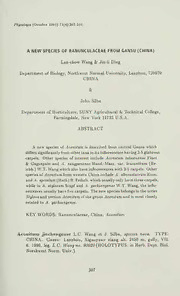Table Of ContentPhytologia (October 1991) 71(4):307-310.
A NEW SPECIES OF RANUNCULACEAE FROM GANSU (CHINA)
Lan-chow Wang & Jin-li Ding
Department of Biology, Northwest Normal University, Lanzhou, 73U070
CHINA
k
John Silba
Department of Horticulture, SUNY Agricultural & Technical College,
Farmingdale, New York 11735 U.S.A.
ABSTRACT
A new species of AcoJiituvi is described from central Gansu which
differssignificantlyfromothertaxainitsinflorescencehaving3-5glabrous
carpels. Other species of interest include Aconitum iatsienense Finet
& Gagnepain and A. sungpanense Hand.-Mazz. var. leucanthum (Re-
ichb.) W.T.Wangwhichalsohaveinflorescences with3-5carpels. Other
species ofAconttumfrom western Chinainclude A. alboviolaceumKom.
and A. apetalum(Huth) B. Fedsch. whichusuallyonlyhavethreecarpels,
while in A. slylosum Stapfand A. yachiangense W.T. Wang, the inflo-
rescences usuallyliavefive carpels. Thenew speciesbelongs in theseries
Stylosaand section Aconitumofthe genus Aconitumand is most closely
related to A. yachiangense.
KEY WORDS: Ranunculaceae, China, Aconitum
Aconitum jiiichengeiise L.C. Wang et J. Silba, species nova. TYPE:
CHINA. Gansu: Lanzhou, Xiguoyuan xiang alt. 2450 m, gully, VII.
6. 1990. leg. L.C. Wang no. 90020{liOWTYVUS: in Herb. Dept. Biol.
Northwest Norm. Univ.)
307
PHYTOLOGIA
308 volume 71(4):307-210 October 1991
^A^.A.
1'
A-i>i'.1u'-.I y ^1-''"-^''•'•••'^ i/'^^s ^'V ^ -i•'-'"
Figure 1. Illustration ofAconitumjtnchengenst L. Wang k, J. Silbafrom Wang
90020{Eoloiype). 1-Tuber; 2-inflorescence; 3-leaf; 4-8-lower and upper sepals;
9-10-anthers; 11-fruit. Figure by Hian-lu Bai (NWN Univ.).
Wang, et al.: New Aconitum 309
Affine A. yachiangense W.T. Wang, a quo tuberibus 2-3; foliis
reniformibus velrotundato-reniformibus; cassibus cylindracis, sepa-
lis inferioribus inaequalibus, sepalis lateralibus et majioribus sepa-
lis inferioribus intus barbatis; carpellis 3-5, glabris differt.
Tubera 2-3, cylindrata, circ. 4-10 cm longa, ad 1.5 cm diam.
Caules erecti ad 1.2 m alti, 5-15 mm diam., pilosi, fistulosi, 4-6
foliati. Folia radicalia et caulina inferiora longe petiolata; petioli
usque ad 70 cm loiigi, lamiua ambitu reniformis vel orbiculato-
reniformis, ad 17 cm longam et circ. 30 cm latam, profunde palma-
tim 3-partita usque ad partes longitudum laminarum, medio par-
j
tilione laterhomboideocuneata, lateralibus obliquo-fiabeUiformibus,
3-fidis, lobis apice acuminatis; marginelobis parvis paucis veldense
acutis trianguiaribus irregularibus; superficies glabra, infra nervos
piloses non nisi; folia caulina similia radicalia, sed supera minora,
petiolata brevia, lobis apiibus acuminatis. Racemi multiflori, ad 60
cm lougi, circ. 45 flori, inferioramiferi; bracteae inferiores foliaceae,
sed superiores lineares; rachis cum pedicellis patente alba puberula;
pedicelli 3-30 mm longi; supra medium bibracteolatis; bracteolae
mm
lineares 3-9 longae, pilis papatulis brevibus. Sepala alba, ex-
mm mm
tus puberula; cassis cyiindracea, 8-20 longa, circ. 5 crassa;
mm
sepala lateralia subrotundata, circ. 8 lata, intus alba barbata;
sepala inferiora inaequalia, magnisepala late ovalis-rotundata circ.
6 mm longa et 5 mm lata, intus alba barbata, microsepala angusti-
mm mm
ovata circ. 6 longa et 3 lata, intus glabra. Fetalis glabris,
mm mm
circ. 15 longis, calcaribus circ. 4 longis, circinatis, lobis
mm mm
labiatis circ. 4 longis, 2-lobatis, unguibus circ. 10 longis.
Stamina circ. 28, glabra, circ. 4 mm longa, filamentum a medio
abrupte dilatatis, margo integer. Carpella 3-5, glabra. Folliculi
circ. 1.2 cm longi, breviter pilosi, in juvenalibus densioribus. Se-
men obovatum, triquetrum, circ. 4 mm longum dense transversum
angustialatum. Fl. et Fr. 7-8.
In the spermatophyte flora of Gansu, this province can be classified into
five geographic regions. Namely, the Hosi Kalidor to the upper north; the
North Qihan mountain region to the lower north; the Gannan region to the
southwest which includes the Yellow River and Taohe River region; the loess
plateau region wliich includes Lanzhou; and lastly, the south Gansu region
which includes thewest QinUng-Bashan mountain region (Wang k Ding 1990).
The relationship betweentheflora distributedin Gansu and Shanxi appears
tohave many related taxa. Interestingly though, the flora distributed in Gansu
and Sichuan appear to have even closer relationships between species. In the
two regions, namely the Gansu-Shanxi flora and the Gansu-Sichuan flora, the
similarity coefficient of genera appears to be approximately 76.8/o and 74.3/o
310 P H Y T L a I A volume 71(4):307-310 October 1991
respectively (Kung 1962; Wu 1979).
The new, previously undetected species Aconilunijmchengense is native to
central Gansu at moderate elevations. This species is related to A. yachian-
genseW.T. Wang, though it differsin having 2-3 tubers; theleavesarereniform
or orbicular-reniform; the corolla cylindrical, the lower sepals reduced, the lat-
eral sepals larger than the lower sepals and provided with beard like cilia or
pubescence; the carpels being 3-5 in number and are glabrous.
LITERATURE CITED
Kung, Hsian-wu. 1962. Fl. Lanzhou. Gansu Press, Lanzhou.
Wang, Lan-chow &: Jin-li Ding. 1990. A preliminary study en the forest flora
of Gansu province. Acta Bot. Boreal-Occident. Sin. 10(3):211-218.
Wu, Cheng-yih. 1979. The regionalization of Chinese Flora. Acta Bot.
Yunnanica l(l):l-22.

